Family name: Petrosaviaceae J. Hutchinson
Synonym(s): Japonoliriaceae Takht.; Miyoshiaceae Nakai; Nartheciaceae Fr. ex Bjurzon tr. Petrosavieae; Nartheciaceae Fr. ex Bjurzon tr. Japonolirieae; Protoliriaceae Makino, nom. inval.
Common name(s): petrosavia family
*Number of genera/species: 2/4
List of genera records in GRIN-Global
seed
Fruit a schizocarpschizocarp:
usually dry fruit splitting between two or more locules to form distinct, indehiscent, usually one seeded segments; fruit derived from a single, superior or inferior, compound ovary; compare to mericarp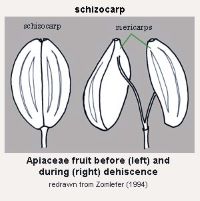 of three folliclesfollicle:
of three folliclesfollicle:
a dry to (rarely) fleshy fruit derived from a single carpel that opens along a single longitudinal suture, derived from a single, superior, simple ovary; the seeds may be arillate or with a fleshy testa , 2–4 mm long, folliclesfollicle:
, 2–4 mm long, folliclesfollicle:
a dry to (rarely) fleshy fruit derived from a single carpel that opens along a single longitudinal suture, derived from a single, superior, simple ovary; the seeds may be arillate or with a fleshy testa basally fused and radiate at maturity (Petrosavia) or not and appearing more like a capsulecapsule:
basally fused and radiate at maturity (Petrosavia) or not and appearing more like a capsulecapsule:
a dry, dehiscent fruit derived from a compound ovary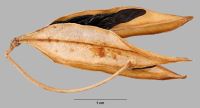 (Japonlirion), with 4–6 seeds (Japonlirion) or many seeds (Petrosavia). Folliclefollicle:
(Japonlirion), with 4–6 seeds (Japonlirion) or many seeds (Petrosavia). Folliclefollicle:
a dry to (rarely) fleshy fruit derived from a single carpel that opens along a single longitudinal suture, derived from a single, superior, simple ovary; the seeds may be arillate or with a fleshy testa trigonous or ellipsoidellipsoid:
trigonous or ellipsoidellipsoid:
3D shape—elliptic
, tereteterete:
approximately circular in cross section; width and thickness approximately equal
 to slightly angledangular:
to slightly angledangular:
2D shape—having sides that meet at acute or obtuse angles
in transection, style or stylar remnantsstyle base:
remnant of a style persistent. Pericarppericarp:
persistent. Pericarppericarp:
fruit wall or fruit coat
white to brown, firm, smooth or striatestriate:
surface relief—having fine, parallel lines, grooves or ridges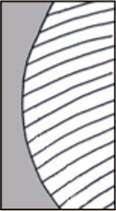 .
.
Seeds oblongoblong:
2D shape—much longer than broad with nearly parallel sides, corners are rounded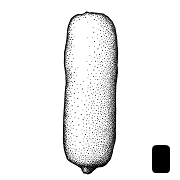 to ovateovate:
to ovateovate:
2D shape—egg-shaped in outline, widest point is towards one end of the organ, the other end tapers gradually, attachment at or near the broad end (compare obovate, ovoid)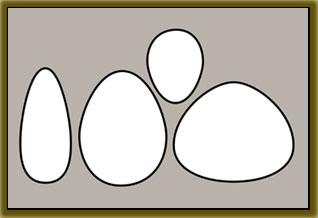 , 0.3–0.8 mm long, hyalinehyaline:
, 0.3–0.8 mm long, hyalinehyaline:
thin, membranous, and translucent or transparent
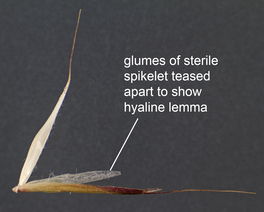 wing around seed body (Petrosavia) or without wings (Japonolirion). Seed coat brown, membranousmembranous:
wing around seed body (Petrosavia) or without wings (Japonolirion). Seed coat brown, membranousmembranous:
texture—extremely thin, pliable, and fairly tough
, reticulatereticulate:
surface relief—netted, raised walls or concave grooves forming a net-like surface pattern with flat, concave, or convex interspaces or striatestriate:
or striatestriate:
surface relief—having fine, parallel lines, grooves or ridges .
.
Embryo rudimentaryrudimentary:
(of embryo) embryo is small and fills less than a quarter of the seed and can be variable in shapes, such as linear, spatulate, or oval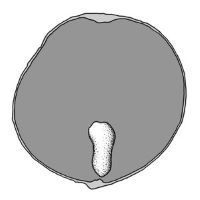 , minute, straight.
, minute, straight.
Endosperm copious.
| Fruit | |
| Type | schizocarpschizocarp: usually dry fruit splitting between two or more locules to form distinct, indehiscent, usually one seeded segments; fruit derived from a single, superior or inferior, compound ovary; compare to mericarp  of folliclesfollicle: of folliclesfollicle:a dry to (rarely) fleshy fruit derived from a single carpel that opens along a single longitudinal suture, derived from a single, superior, simple ovary; the seeds may be arillate or with a fleshy testa  |
| Size range | 2–4 mm long |
| Shape(s) | trigonoustrigonous: 3D shape—having three faces that meet at distinct angles; triangular in outline or ellipsoidellipsoid: 3D shape—elliptic |
| Texture | firm |
| Surface relief | smooth, striatestriate: surface relief—having fine, parallel lines, grooves or ridges  |
| Color(s) | white, light brown |
| Unique features | Small, schizocarpschizocarp: usually dry fruit splitting between two or more locules to form distinct, indehiscent, usually one seeded segments; fruit derived from a single, superior or inferior, compound ovary; compare to mericarp  of three-follicles, white or brown. FolliclesFollicle: of three-follicles, white or brown. FolliclesFollicle:a dry to (rarely) fleshy fruit derived from a single carpel that opens along a single longitudinal suture, derived from a single, superior, simple ovary; the seeds may be arillate or with a fleshy testa  trigonous or ellipsoidellipsoid: trigonous or ellipsoidellipsoid:3D shape—elliptic , basally united and recurved or weakly, united along length. |
| Seed | |
| Size range | 0.3–0.8 mm long |
| Shape(s) | oblongoblong: 2D shape—much longer than broad with nearly parallel sides, corners are rounded  , ellipsoidellipsoid: , ellipsoidellipsoid:3D shape—elliptic , ovoidovoid: 3D shape—ovate 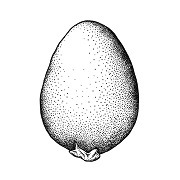 |
| Surface relief | reticulatereticulate: surface relief—netted, raised walls or concave grooves forming a net-like surface pattern with flat, concave, or convex interspaces  , striatestriate: , striatestriate:surface relief—having fine, parallel lines, grooves or ridges  |
| Color(s) | brown |
| Unique features | Small, brown seeds with membranousmembranous: texture—extremely thin, pliable, and fairly tough , reticulatereticulate: surface relief—netted, raised walls or concave grooves forming a net-like surface pattern with flat, concave, or convex interspaces  seed coats. Or, minute brown seeds, with hyalinehyaline: seed coats. Or, minute brown seeds, with hyalinehyaline:thin, membranous, and translucent or transparent  wing around seed body, and membranousmembranous: wing around seed body, and membranousmembranous:texture—extremely thin, pliable, and fairly tough , striatestriate: surface relief—having fine, parallel lines, grooves or ridges  seed coats. seed coats. |
| Other | |
| Embryo | rudimentaryrudimentary: (of embryo) embryo is small and fills less than a quarter of the seed and can be variable in shapes, such as linear, spatulate, or oval  , minute, straight , minute, straight |
| Nutritive tissue | endosperm copious |
Eastern Asia, West Malesia.
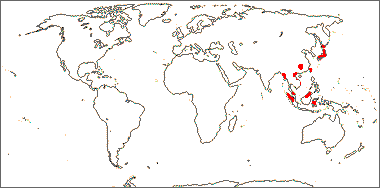
Distribution map courtesy of Angiosperm Phylogeny Website.
Baskin and Baskin 2021Baskin and Baskin 2021:
Baskin C and Baskin J. 2021. Relationship of the lateral embryo (in grasses) to other monocot embryos: A status up-grade. Seed Science Research 31 (3): 199-210. doi:10.1017/S0960258521000209; Dahlgren et al. 1985Dahlgren et al. 1985:
Dahlgren RMT, Clifford HT, and Yeo PF. 1985. The families of the monocotyledons: structure, evolution, and taxonomy. Springer-Verlag, Berlin. 520 pp.; Kirkbride et al. 2006Kirkbride et al. 2006:
Kirkbride JH, Jr, Gunn CR, and Dallwitz MJ. 2006. Family guide for fruits and seeds, vers. 1.0. Accessed September 2020-January 2022. URL: https://nt.ars-grin.gov/seedsfruits/keys/frsdfam/index.cfm .; Kubitzki et al. 1990+Kubitzki et al. 1990+:
Kubitzki K et al., eds. 1990+. The families and genera of vascular plants. 7+ vols. Berlin etc.; Nooteboom et al. 2021+Nooteboom et al. 2021+:
Nooteboom HP, de Wilde WJJO, Stevens PF, Coode MJE, and Saw LG. 2021+ Flora Malesiana Online. Accessed January 2021–March 2024. URL: https://portal.cybertaxonomy.org/flora-malesiana/; Ohwi 1965Ohwi 1965:
Ohwi J. 1965. Flora of Japan: in English: combined, much revised, and extended translation. Meyer FG and Walker EH (eds). Smithsonian Institution, Washington, D.C. 1067 pp. https://doi.org/10.5962/bhl.title.43786; Remizowa et al. 2017Remizowa et al. 2017:
Remizowa MV, Nuraliev MS, Averyanov Leonid V, Kuznetsov AN, and Kuznetsova SP. 2017. A revision of the family Petrosaviaceae in Vietnam. Nordic Journal of Botany 35 (3): 262-271. https://doi.org/10.1111/njb.01480; Stevenson and Loconte 1995Stevenson and Loconte 1995:
Stevenson DW and Loconte H. 1995. A cladistic analysis of monocot families. In: Rudall PJ, Cribb PJ, Cutler DF, and Humphries CJ, eds. Monocotyledons: Systematics and Evolution. Royal Botanic Gardens, Kew.; Takhtajan 2009Takhtajan 2009:
Takhtajan A. 2009. Flowering plants: Second edition. Springer Nature, Switzerland. 871 pp.; Watson and Dallwitz 1992+Watson and Dallwitz 1992+:
Watson L and Dallwitz MJ. 1992+. The families of flowering plants: descriptions, illustrations, identification, and information retrieval. Version: 6th Accessed September 2020-September 2022. URL: delta-intkey.com; Zhengyi et al. 2004+Zhengyi et al. 2004+:
Zhengyi W, Raven PH, and Deyuan H. 2004+. Flora of China [online]. 25 vols. Science Press, Beijing China & Missouri Botanical Garden, St. Louis USA. Accessed January–March 2024. http://flora.huh.harvard.edu/china/
*The number of genera and species is based on Christenhusz and Byng 2016Christenhusz and Byng 2016:
Christenhusz MJM and Byng JW. 2016. The number of known plant species in the world and its annual increase. Phytotaxa 261 (3): 201-217. https://doi.org/10.11646/phytotaxa.261.3.1, which may differ from the number of genera in GRIN-Global.